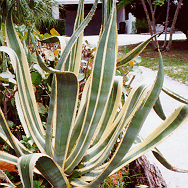Agave
This large group consists of rosette-forming succulents, which are usually short-stemmed, although some varieties will form stems up to 3 feet high. Agaves are mostly natives of Mexico, though some are found wild in the West Indies and a few in the United States. They may be planted outdoors in mild climates, especially those that are desert and semi-desert; otherwise, they may be grown in a greenhouse and when small, as houseplants. In regions with harsh winters, Agaves may be planted outdoors in the summer and brought in during the winter. The sizes of the Agaves vary from 6 inches to 15 feet wide between the species. The blue-green to grayish-green leaves of these plants are tipped with a sharp thorn. When the rosette is mature, which is about five years for smaller varieties and up to forty years for larger species, the growing point grows into a tall flower spike. The flowering process can take almost a year. Some flower stalks grow up to thirty feet high. The bell-shaped flowers are long lasting and usually come in shades of green, yellow, or white. Small berries follow the blossoms, after which the entire plant dies leaving younger offsets to grow on. A. americana (Century Plant; American Aloe; Maguey) is an interesting variety with large rosettes of thick, green leaves that grow 3 to 6 feet long and 6 to 9 inches wide. They are edged with sharp hooks. This plant will bloom after ten or more years, producing a tall flower spike that is 6 to 25 feet high and is covered with thick bunches of comparatively small, yellowish-green
flowers. A. americana var. Variegata produces yellow margined leaves that grow up to 5 feet long. After twenty to thirty years, a flower spike, ranging in height from 6 to 25 feet, is produced on which large, fragrant, creamy flowers grow. A stricta is one of the few Agaves that doesn't die after flowering. It produces a short trunk, which branches to form new growing points. This plant grows up to 2 feet high and 5 feet wide with thin, light green leaves. After 10 or 15 years, a spike of white flowers is produced. After the first blossoming, a flower spike is borne every 5 to 10 years. A. parviflora (Little Princess Agave) grows up to 6 inches high and 9 inches wide and makes a great houseplant. The dark green leaves are marked with white and have white fibers curling from the edges. After seven years, green flowers are produced on a spike growing 4 to 6 feet high. The flowers are usually self-fertile if pollinated. Agaves produce excellent fiber in their leaves, which produces the strengthening element that allows them to maintain their rigidity. The two main sources of fiber are A. sisalana and A. fourcroydes. The former produces the Sisal of Hemp and the latter produces Henequen or Yucatan Hemp. The Mexican beverages, pulque and mescal, are obtained from A. atrovirens.
POTTING
Agaves need minimum temperatures ranging from 23º to 36º F depending upon the variety. Agaves need very porous soil in a sunny location. The best compost consists of two parts fibrous loam, one part broken bricks and one part sand, with a little bone meal and dried cow manure added. When growing indoors, a lot of drainage should be placed in the bottom of the container and their soil should be patted firmly. They should be planted in March and April. Repotting isn't necessary for several years because they grow so slowly. They do better in smaller pots, anyway.
PROPAGATION
Agaves can be increased by seeds, suckers and plantlets. Sometimes suckers develop around the base of old plants. Plantlets may also form on the flowering stems and may be detached and repotted. Seeds may be planted in pots of sandy soil.

A. americana
VARIETIES
- A. albicans;
- A. albomarginata
- A. americana (Century Plant; American Aloe; Maguey) & var. variegata, marginata;
- A. angustifolia
- A. applanata
- A. atrovirens;
- A. attenuata;
- A. aurea
- A. bourgaei
- A. ferox;
- A. filfera;
- A. fourcroydes.
- A. Kerchovei
- A. noli-tangere;
- A. parryi (Mescal Agave);
- A. parviflora (Little Princess Agave);
- A. pumila;
- A. Victoriae-Reginae;
- A. utahensis (Utah Agave);
- A. Salmiana;
- A. scabra;
- A. sisalana;
- A striata;
- A. stricta;





